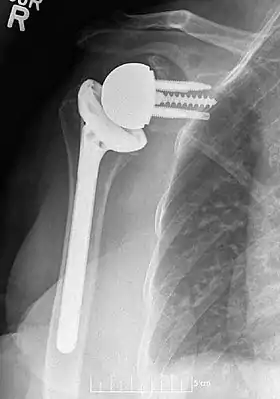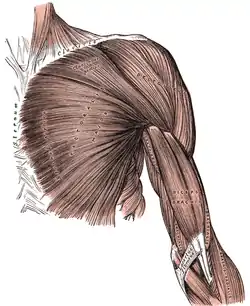Reverse shoulder replacement
Reverse shoulder replacement is a type of shoulder replacement in which the normal ball and socket relationship of glenohumeral joint is reversed, creating a more stable joint with a fixed fulcrum.[1] This form of shoulder replacement is utilized in situations in which conventional shoulder replacement surgery would lead to poor outcomes and high failure rates.[2]
| Reverse shoulder replacement | |
|---|---|
 Plain film radiograph in anteroposterior (AP) view of a right shoulder status post reverse shoulder arthroplasty using a prosthesis with a lateralized center of rotation. | |
| ICD-9-CM | 81.80-81.81 |
| MedlinePlus | 007387 |
Originally considered a salvage procedure, the combination of improved design features and excellent clinical outcome data has led to reverse shoulder replacement largely replacing shoulder hemiarthroplasty for most indications,[3] and even challenging conventional anatomic shoulder replacement in many countries as the most commonly performed shoulder replacement procedure.[4]
Medical uses
Historically, the primary indication to perform reverse shoulder replacement was cuff tear arthropathy, which consists of advanced glenohumeral arthritis in the presence of a massive rotator cuff tear.[5] As reverse shoulder replacement has become more popular, the indications have expanded to include shoulder “pseudoparalysis” due to massive rotator cuff tears, shoulder fractures, severe bone loss on the scapula or humerus precluding the use of standard implants and failed prior shoulder replacement procedures.[6]
Surgical techniques

The procedure is performed through a deltopectoral approach, in which the space between the deltoid muscle and pectoralis major muscle is developed. The subscapularis muscle, one of the four muscles of the rotator cuff, is typically detached to perform the operation. The native humerus and scapula bones are prepared using precise machining to accommodate their respective implants. At the end of the procedure, the subscapularis muscle is typically repaired, although some surgeons advocate not repairing this muscle due to the excess tension placed on it by the altered mechanics of the reverse shoulder design.[7]
It is worth noting that this is an implant specific phenomenon, as certain reverse shoulder designs disrupt the normal anatomical relationships significantly while others attempt to restore these closer to what is considered normal anatomy.[8]
Implants
Modern reverse shoulder implants consist of multiple parts. On the scapula bone, there is a metallic baseplate that grows into the bone of the native glenoid, screws and/or pegs that hold this in place, and a round metallic “glenosphere” component that is mated to the baseplate via several different mechanisms. On the humerus bone, there is typically a concave polyethylene liner that articulates with the convex glenosphere and is attached to a humeral stem that grows into the native humerus or is cemented into place. Within this basic structure there are multiple different variations of implants, and to date there is no consensus on which design is superior, although several studies have demonstrated some benefits to certain combinations.[9][10][11] One such modern reverse shoulder implant system is the AltiVate Reverse. More information on this system can be found on the DJO website.

History
Traditional shoulder replacement (known as anatomic shoulder replacement) was developed to treat glenohumeral arthritis and consists of resurfacing the native humeral head and glenoid to create smooth articular surfaces to provide pain relief and improved range of motion. Variations of this procedure have been performed as early as 1883.[5] While most patients can achieve substantial clinical improvement using this approach, those with large rotator cuff tears have consistently demonstrated poor outcomes due to loss of the stability provided by these muscles.[2]
In 1972, U.S. orthopedic surgeon Charles S. Neer designed a fixed-fulcrum shoulder replacement in which he reversed the ball and socket geometry.[12] Unfortunately, his design resulted in several early failures, leading him to abandon this concept. Multiple other surgeons throughout the world subsequently developed reversed ball and socket implants, and while some achieved reasonably good results,[13] the concept never gained significant traction until French surgeon Paul Grammont developed his “Trompette” prosthesis in 1985. This was further modified into the Delta III prosthesis in 1991. As Grammont's reverse ball and socket prosthesis gained popularity and began demonstrating reliable outcomes,[14] he subsequently developed what would be known as the “Grammont Principles”,[15] which were a set of rules that explained why his prosthesis was effective and why other reverse ball and socket designs failed.
In 1998, U.S. orthopedic surgeon Mark Frankle began designing a reverse ball and socket prosthesis that did not adhere to the traditional Grammont Principles. He began patenting this device, the RSP (Reverse Shoulder Prosthesis), in 2002.[16] Many doubted the effectiveness of his design and suggested that it would lead to higher failure rates, creating significant controversy and debate within the orthopedic community.[17] After validating his theories with rigorous scientific studies[9] and making several key modifications to his design,[1] Frankle ultimately developed an implant that was able to address the shortcomings of the Grammont-style prostheses while also showing excellent survivorship.[18] Multiple studies have since gone on to demonstrate the advantages of his design principles,[19][10][11] and many of the modern generation reverse shoulder implants have mirrored them.[20]
With good outcome in Rotator cuff arthropathy, the indications for performing reverse shoulder arthroplasty has also expanded to all the situations where the rotator cuff function will be compromised such as unreconstructible fractures of proximal humerus, fracture sequelae, revision shoulder arthroplasty, shoulder instability along with arthritis and proximal humerus bone tumours.
References
- Walker M, Brooks J, Willis M, Frankle M (September 2011). "How reverse shoulder arthroplasty works". Clinical Orthopaedics and Related Research. 469 (9): 2440–51. doi:10.1007/s11999-011-1892-0. PMC 3148368. PMID 21484471.
- Pollock RG, Deliz ED, McIlveen SJ, Flatow EL, Bigliani LU (July 1992). "Prosthetic replacement in rotator cuff-deficient shoulders". Journal of Shoulder and Elbow Surgery. 1 (4): 173–86. doi:10.1016/1058-2746(92)90011-Q. PMID 22971621.
- Schairer WW, Nwachukwu BU, Lyman S, Craig EV, Gulotta LV (October 2015). "Reverse shoulder arthroplasty versus hemiarthroplasty for treatment of proximal humerus fractures". Journal of Shoulder and Elbow Surgery. 24 (10): 1560–6. doi:10.1016/j.jse.2015.03.018. PMID 25958208.
- Westermann RW, Pugely AJ, Martin CT, Gao Y, Wolf BR, Hettrich CM (2015). "Reverse Shoulder Arthroplasty in the United States: A Comparison of National Volume, Patient Demographics, Complications, and Surgical Indications". The Iowa Orthopaedic Journal. 35: 1–7. PMC 4492145. PMID 26361437.
- Flatow EL, Harrison AK (September 2011). "A history of reverse total shoulder arthroplasty". Clinical Orthopaedics and Related Research. 469 (9): 2432–9. doi:10.1007/s11999-010-1733-6. PMC 3148354. PMID 21213090.
- Walker M, Willis MP, Brooks JP, Pupello D, Mulieri PJ, Frankle MA (April 2012). "The use of the reverse shoulder arthroplasty for treatment of failed total shoulder arthroplasty". Journal of Shoulder and Elbow Surgery. 21 (4): 514–22. doi:10.1016/j.jse.2011.03.006. PMID 21641825.
- Werner BC, Wong AC, Mahony GT, Craig EV, Dines DM, Warren RF, Gulotta LV (March 2018). "Clinical Outcomes After Reverse Shoulder Arthroplasty With and Without Subscapularis Repair: The Importance of Considering Glenosphere Lateralization". The Journal of the American Academy of Orthopaedic Surgeons. 26 (5): e114–e119. doi:10.5435/JAAOS-D-16-00781. PMID 29419724.
- Berhouet J, Garaud P, Favard L (December 2013). "Influence of glenoid component design and humeral component retroversion on internal and external rotation in reverse shoulder arthroplasty: a cadaver study". Orthopaedics & Traumatology, Surgery & Research. 99 (8): 887–94. doi:10.1016/j.otsr.2013.08.008. PMID 24211248.
- Gutiérrez S, Comiskey CA, Luo ZP, Pupello DR, Frankle MA (December 2008). "Range of impingement-free abduction and adduction deficit after reverse shoulder arthroplasty. Hierarchy of surgical and implant-design-related factors". The Journal of Bone and Joint Surgery. American Volume. 90 (12): 2606–15. doi:10.2106/JBJS.H.00012. PMID 19047705.
- Keener JD, Patterson BM, Orvets N, Aleem AW, Chamberlain AM (February 2018). "Optimizing reverse shoulder arthroplasty component position in the setting of advanced arthritis with posterior glenoid erosion: a computer-enhanced range of motion analysis". Journal of Shoulder and Elbow Surgery. 27 (2): 339–349. doi:10.1016/j.jse.2017.09.011. PMID 29332666.
- Werner BS, Chaoui J, Walch G (October 2017). "The influence of humeral neck shaft angle and glenoid lateralization on range of motion in reverse shoulder arthroplasty". Journal of Shoulder and Elbow Surgery. 26 (10): 1726–1731. doi:10.1016/j.jse.2017.03.032. PMID 28528016.
- Pupello D (2016). "Origins of Reverse Shoulder Arthroplasty and Common Misconceptions". Reverse Shoulder Arthroplasty. pp. 3–18. doi:10.1007/978-3-319-20840-4_1. ISBN 978-3-319-20839-8.
- Kessel L, Bayley I (October 1979). "Prosthetic replacement of shoulder joint: preliminary communication". Journal of the Royal Society of Medicine. 72 (10): 748–52. doi:10.1177/014107687907201010. PMC 1437172. PMID 552433.
- Grammont PM, Baulot E (January 1993). "Delta shoulder prosthesis for rotator cuff rupture". Orthopedics. 16 (1): 65–8. doi:10.3928/0147-7447-19930101-11. PMID 8421661.
- Baulot E, Sirveaux F, Boileau P (September 2011). "Grammont's idea: The story of Paul Grammont's functional surgery concept and the development of the reverse principle". Clinical Orthopaedics and Related Research. 469 (9): 2425–31. doi:10.1007/s11999-010-1757-y. PMC 3148374. PMID 21210311.
- US granted 6790234, Frankle MA, Moad DC, "Reverse shoulder prosthesis system", published 4 January 2002, issued 14 September 2004, assigned to Encore Medical Asset Corp
- Pupello D, Frankle M (December 2011). "Regarding "Observations on retrieved humeral polyethylene components from reverse total shoulder arthroplasty"". Journal of Shoulder and Elbow Surgery. 20 (8): e22–3. doi:10.1016/j.jse.2011.01.026. PMID 21482152.
- Cuff DJ, Pupello DR, Santoni BG, Clark RE, Frankle MA (November 2017). "Reverse Shoulder Arthroplasty for the Treatment of Rotator Cuff Deficiency: A Concise Follow-up, at a Minimum of 10 Years, of Previous Reports". The Journal of Bone and Joint Surgery. American Volume. 99 (22): 1895–1899. doi:10.2106/JBJS.17.00175. PMID 29135662.
- Gee, Edward C.A.; Hanson, Emma K.; Saithna, Adnan (2015-07-31). "Reverse Shoulder Arthroplasty in Rheumatoid Arthritis: A Systematic Review". The Open Orthopaedics Journal. 9 (1): 237–245. doi:10.2174/1874325001509010237. ISSN 1874-3250. PMC 4591906. PMID 26448802.
- Middernacht B, Van Tongel A, De Wilde L (2016). "A Critical Review on Prosthetic Features Available for Reversed Total Shoulder Arthroplasty". BioMed Research International. 2016: 1–9. doi:10.1155/2016/3256931. PMC 5220426. PMID 28105417.